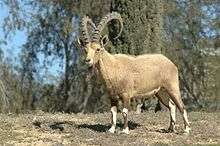Nubian ibex
| Nubian ibex | |
|---|---|
 | |
| Male | |
| Female | |
| Scientific classification | |
| Kingdom: | Animalia |
| Phylum: | Chordata |
| Class: | Mammalia |
| Order: | Artiodactyla |
| Family: | Bovidae |
| Subfamily: | Caprinae |
| Genus: | Capra |
| Species: | C. nubiana |
| Binomial name | |
| Capra nubiana F. Cuvier, 1825 | |
The Nubian ibex (Capra nubiana) is a desert-dwelling goat species found in mountainous areas of Algeria, Egypt, Ethiopia, Eritrea, Israel, Jordan, Lebanon, Oman, Saudi Arabia, Sudan, and Yemen. It is historically considered to be a subspecies of the Alpine ibex (Capra ibex), but is increasingly considered a specifically distinct species (Capra nubiana). The wild population is estimated at 1,200 individuals.
Description

Nubian ibexes stand around 65–75 cm (2.1–2.6 ft) tall at the shoulder and weigh around 50 kilograms (110 lb). Nubian ibexes are a light tan color, with a white underbelly; in males there is also a dark brown stripe down the back. Nubian ibexes have long thin horns which extend up and then backwards and down. In males these reach around a metre in length while in females they are much smaller (around 30 cm or 12 in).[2]
Ecology

Nubian ibexes live in rough dry mountainous terrain where they eat mainly grasses and leaves and are preyed upon by leopards, wolves, common foxes, eagles and bearded vultures. Nubian ibexes are social and herds tend to consist of females, young, and males up to the age of about three years. The males are solitary or form more transitory bands of up to eight individuals. During the breeding season males join the female-based herds for the six to eight week rut. Large males then do battle with much clashing of horns.[2]
Nubian ibexes are diurnal, meaning they are active during the day and rest during the night. On 16 March 1959, the British established the Yob Wildlife Reserve in northern Eritrea specifically to protect significant populations of Nubian ibex in the area.[3][4]
Status
.jpg)
The International Union for Conservation of Nature has classified the Nubian ibex as "vulnerable". This is on the basis that there are fewer than 10,000 mature individuals and the population is declining. Threats faced by the animal include competition with livestock for water and fodder, hunting pressure and habitat destruction.[1]
In popular culture
The Biblical heroine Yael's name means "Ibex" in Hebrew. The Nubian ibex in particular was in the BBC documentary Life, and featured prominently in the popular television documentary series Planet Earth (episode 5, "Deserts").[5]
References
| Wikimedia Commons has media related to Capra nubiana. |
- 1 2 Alkon, P. U.; Harding, L.; Jdeidi, T.; Masseti, M.; Nader, I.; de Smet, K.; Cuzin, F. & Saltz, D. (2008). "Capra nubiana". The IUCN Red List of Threatened Species. IUCN. p. e.T3796A10084254. doi:10.2305/IUCN.UK.2008.RLTS.T3796A10084254.en. Retrieved 12 January 2018. Database entry includes a brief justification of why this species is of vulnerable.
- 1 2 Jonathan Kingdon; David Happold; Thomas Butynski; Michael Hoffmann; Meredith Happold; Jan Kalina (2013). Mammals of Africa. A&C Black. pp. 600–603. ISBN 978-1-4081-8996-2.
- ↑ "Yob Wildlife Reserve". Protectedplanet.net. Retrieved 30 May 2012.
- ↑ Shackleton, David M. (1997). Wild Sheep and Goats and Their Relatives: Status Survey and Conservation Action Plan for Caprinae. International Union for Conservation of Nature and Natural Resources. Species Survival Commission. Caprinae Specialist Group. p. 26. ISBN 978-2-8317-0353-4. Retrieved 30 May 2012.
- ↑ Produced by Huw Cordey (2006-04-02). "Deserts". Planet Earth. BBC. BBC One.
